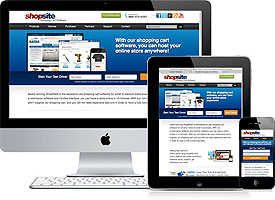The Importance of Search Engine Optimization
Start your summer off right by looking through your website for any areas you can improve. For this article, we will focus on Search Engine Optimization (SEO). With the ever-changing algorithms used by search engines, your SEO strategy is something which requires constant work.
Here are a few factors which most SEO experts agree are essential parts of a good strategy:
- Have unique content for your web pages (i.e., use your own product descriptions if you are a reseller for a manufacturer or vendor).
- Make sure all category and product page URLs are content specific and not generic. For example, “HP-Toner-Cartridges.html” (specific) vs “page7.html” (generic). File names are controlled in ShopSite under Pages > Edit Page Content > Advanced Info.
- Assign alt tags to your images (Images > Edit Image).
- Make sure your XML and HTML sitemaps are up to date. ShopSite Manager and Pro packages are integrated with Google for sitemap generation. This feature is found under Merchandising > Google Services > Sitemap.
- Check your page load time both on desktop devices as well as mobile. Long load times are penalized by Search Engines. Not only that, but most customers are not going to wait around. If your site takes too long to load, they will leave.
Remember, having a website which looks amazing will not mean a thing if potential customers cannot locate it using search engines.
Below are some references:
- If You Build It They Will Come—Not Unless You Work On It
- 8 Ways to Increase The Relative Traffic of Your Site
Making Your Website Customer Friendly
The above article was concerning how to make your website more visible to customers coming through search engines. This article touches on how to improve your website so your customers will be more likely to make a purchase.
First, make sure that your contact information, shipping policies, refund policies, and return policies are easy to find. Customers want to know that if they have a question they can get a hold of you. They also want to know how soon they can expect a product to arrive, as well as what options they have for returning the product if they do not like it. We recommend placing your phone number within the header of every page and making sure it is large.
Second, provide high quality pictures of your products. If necessary, provide pictures from multiple angles for each product. Customers like to have a good idea of what the product looks like.
Third, have someone (preferably someone who has never been there before, like a friend, neighbor, etc) go through the website (preferably someone who has never been there before) go through the website to find a couple of specific products. Ask them how easy they feel it is to navigate your website and find what they need. Not all customers are patient. As a result, if a customer cannot find what they need quickly (or if they do not feel the mouse clicks are getting them anywhere), then they will shop elsewhere.
Finally, add product reviews and security scans (such as VeriSign Secured, McAfee Secure, etc). Reviews allow customers to see how others feel and what their experience was with your company or product. Security scans tell customers that even though they may not have heard of your company before, your website is set to handle their information safely and securely. Product reviews and trust marks together help customers feel more at ease with your company.
So, to recap, step one is getting customers to your website (through search engines, email marketing, advertisements, etc). Step two is making sure your customers can find what they need on your website and giving them a reason to trust you.
 |
Get your FREE Website SEO Analysis
Learn More: Specifically designed ShopSite SEO packages (as low as $49 per month). Get Your Free Set Analysis Now! |
Merchant Tip
Question: I just received an order in my store now how do I process it?
Answer: You just received an order in your store--but you don't want to take credit card orders or you want them all to go through PayPal! Chances are your current ShopSite payment settings are configured to manually accept credit cards such as Visa, Mastercard and Discover.
To review your Payment Setup configurations, go to Commerce > Payment Setup. Under the Credit Card Processing menu, you may choose to Manually Process your credit card payments or set Credit Card Processing Offline. If you only wish to take payments through a third party service such as PayPal or Google Checkout, or you do not wish to accept any credit card information with your store, you will need to uncheck *all* Credit Card options from the list.
If you will be accepting credit cards, you will need to review your Credit Card Storage settings by going to Orders > Security > Credit Card Storage. Select "Symmetric" encryption or configure "Asymmetric" encryption if you will need to view the credit card information from your orders. Or, by selecting "Do not store Credit Cards," ShopSite will not remember any credit card information that was provided with an order.
The Support Queue
Question: I received an email notification from WorldPay that on May 30th, 2013, they would be making changes to the domains used to access their production environment and test environment. Does this affect my ShopSite? Is there anything that I need to do?
Answer: Yes, this will affect ShopSite's integration with WorldPay. The current version of ShopSite, ShopSite 11 sp2 r5.1, and earlier access the WorldPay production servers using the domain 'secure.wp3.rbsworldpay.com', which, according to the WorldPay email, will be incorrect after 30th of May, 2013.
Future versions of ShopSite will be modified to use the new 'secure.worldpay.com' domain by default. In ShopSite 11 sp2 r5.1 and earlier, to continue to use the WorldPay functionality in ShopSite after May 30th, 2013 you will need to edit the worldpay.aa settings file in your store's ShopSite Data Directory (you can find the path to this Data Directory listed at the bottom of the Preferences -> Hosting Service menu in your ShopSite backoffice) and change the following line:
HOST: secure.wp3.rbsworldpay.com
to:
HOST: secure.worldpay.com
This change is all that is required for ShopSite to access the WorldPay production servers at the new domain name. ShopSite does not currently have an option to use the WorldPay test environment, although that option may be added in the future.
Designer Tip
 Question: Can ShopSite custom templates be done in responsive design?
Question: Can ShopSite custom templates be done in responsive design?
Answer: Yes. ShopSite creates static HTML pages; any code you would put on a regular responsive design page, you would be able to include within a ShopSite custom template.
Responsive design coding is a hot topic lately, and it seems like it is a trend that is going to stay. Responsive design is a web page that will adjust the display depending on the size of the browser. The good thing about this type of coding is that your website will be able to adjust to the new phones, tablets, and other web devices that are coming out these days. If you are just getting started with responsive design, there are three main things you want to know. First, all pages need to have a meta tag that tells smaller devices to use their regular width, rather than the page width. The meta tag would be something similar to: <meta name="viewport" content="width=device-width, initial-scale=1.0">
The second thing you will want to do when coding for responsive design is code in percentages. All page areas, divs, images, etc, should have percentage widths rather than pixel widths. You can set a max width so that on wide screen monitors your website is still readable. One unique thing about percentages is for images. You will not want to include dimensions on your images. Instead, make sure all your images are within blocked areas (such as a div or an element with a CSS specification of display: block;) then in your CSS, specify the image with a max-width: 100%. This will make it so that images adjust with the browser size.
The third main thing you will want to know when coding for responsive design, is how to make elements completely change with widths. There are different ways of doing this, such as with JavaScript or PHP, but our designer prefers to use CSS. In your CSS file (she typically does this at the end of her CSS files), you can surround entire sections in something that looks like the following, so that you can give different CSS styles to elements at certain browser widths.
@media screen and (max-width : 500px) {
div.footer-navigation {display: none;}
header {background: #495823;}
} |
ShopSite and Avalara have partnered together to deliver on-demand, fully integrated sales and use tax management solutions – saving time, ensuring accuracy, and providing transactional tax compliance. As the leading provider of sales tax management solutions, Avalara is delivering a broad range of calculation and compliance solutions that removes the tedious work and complexities involved with calculating, reporting, returning, and remitting sales and use tax. |
Industry Articles
How the Quality of Your Website Can Make or Break Your SEO Success
"An attractive design can impress and engage users, whereas a bad design can turn off users, contributing to a high bounce rate and low average time on site. If this happens enough, the search engines will perceive these negative signals as the result of a poor user experience, and reduce your site’s rankings."
10 Simple Things SMB Websites Need to Fix Before SEO
"While SEO is an important channel, the ROI that can come from improving customer conversion rates on your website can’t be beat — assuming you actually have people coming to your website in the first place."
Tips to Improve Your Website's E-Commerce Conversion Rate Even for the Greatest of Skeptics
"When we take on new e-commerce conversion projects, we think about user experience from the perspective of a lot of different personas/user types who may visit your site. One of the most important filters through which we think is the skeptic. As sales people, what do we need to do to encourage skeptical and uneasy people? How can we put them at ease and address their concerns before they even know they are having them?"
Recent ShopSite Blog Articles
The following articles were recently added to the ShopSite Blog:
Top 5 E-commerce Posts for April
Top E-commerce Posts for March
Top E-commerce Posts for February 2013
 |
Create and send professional e-mail newsletters, promotions, announcements, and more with Constant Contact®
Try it free for 60 days and see for yourself! |
Recent Knowledgebase Articles
The following articles were recently added to the ShopSite Knowledgebase:
May 2, 2013 email from WorldPay regarding changes to transaction URLs as of May 30, 2013
v11 sp2 r5 maintenance release fixes some problems with v11 sp2 r4
Current Version of ShopSite
Latest Releases:
- Version 11 sp2 r5 on Linux, FreeBSD, Solaris/SPARC, and Windows (2003 and 2008 (32-bit))
To upgrade your ShopSite store, contact your authorized ShopSite reseller hosting partner.